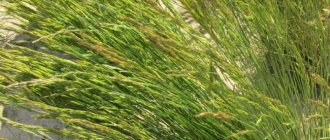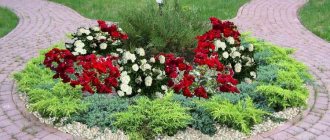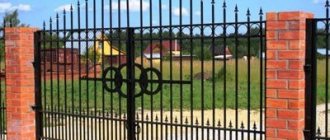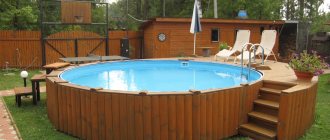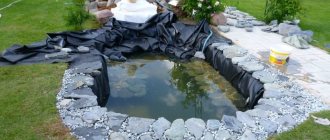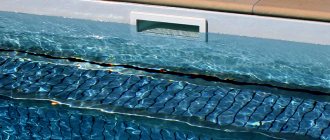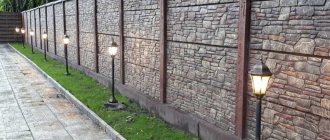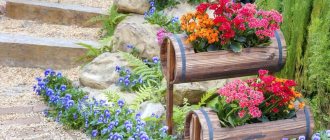Maintaining a green parking lot
Eco-parking does not require much maintenance.
As the grass grows, it must be mowed and fed, taking into account the characteristics of the soil and the type of plant. The area should be cleared of debris, soil should be added to the cells, and grass seeds should be sown in places where “bald spots” have appeared.
In winter, you should be careful that your snow blower does not damage the parking grille.
It is better to plan in advance and purchase grilles that will withstand all vehicles that will park on your territory and all possible maneuvers. If the grille does break, then to replace the broken elements it may be necessary to re-lay the entire area.
Eco-parking can decorate a summer cottage, the courtyard of a private or apartment building, a city street or square:
For more information about lawn gratings, their application and installation technology, watch the video:
Many car owners with garden plots would like to combine a beautiful green lawn with parking for their own car. Purchasing a lawn grill will solve two issues at once. You will receive an excellent garden path and parking for cars at the dacha. There are plastic and concrete gratings; you can familiarize yourself with the options for designing lawns by looking at the photo. They are convenient and practical, they are easy to install. Yes, and such a lawn will not require special care.
The use of lawn gratings has its positive and negative sides. Therefore, before installing them on your personal plot, you need to familiarize yourself with the pros and cons of operation.
The positive aspects of use include:
- Easy to install. The work of installing a lawn grate can be done on your own.
- The eco-parking keeps its shape at any time of the year thanks to the presence of a layer of crushed stone and geofabric.
- The lawn is absolutely non-traumatic. Therefore, even small children can play on it.
- Eco-parking is maintained using simple gardening tools.
- Lawn grates are environmentally friendly and do not interfere with the natural growth of vegetation.
- The green parking lot can be used as a recreation area or as a picnic area.
There are slightly fewer disadvantages, but they are also worth considering:
- It is necessary to accurately calculate the load on the grid. The material deteriorates over time. So, plastic varieties are suitable for passenger cars, and concrete varieties are suitable for trucks.
- After rain it is very difficult to remove accumulated water.
- Concrete gratings become very hot from the sun's rays, which negatively affects plant growth.
- The weight of concrete gratings is very large.
Technology for laying lawn gratings
To install a lawn grate, you do not need to have special knowledge; anyone can handle this work. The installation work can be divided into several stages.
Before starting work, you should decide on the purpose of the territory and mark it. Perhaps you need to strengthen the entire lawn or build only a sports field, parking, recreation area, etc.
Further work is almost the same for both plastic and concrete gratings.
Soil preparation
We remove the top layer of soil. The depth depends on the purpose of the site. Let's calculate using the example of a car parking space:
- A cushion made of sand and gravel: its height depends on the expected load and ranges from 5 to 20 cm. In our case, the height of the cushion should be 20 cm, so not only a passenger car, but also a microbus can enter the parking lot;
- Leveling layer, the height of which can be up to 3 cm;
- The lawn grid itself is 5 cm high.
It turns out that to install the grating we will have to remove the ground to a depth of 28 cm.
Tamping
After preparing the pit, it is necessary to compact the soil and strengthen the walls. This is done using brick or rubble stone. You can strengthen the walls with.
Cushion installation, geotextile laying, leveling
To construct the cushion, gravel or crushed stone and sand are used. Sand is needed to fill the voids between the crushed stone, which prevents it from sagging under load.
We lay geotextiles on the sand-gravel bed; it will protect against weeds and serve as a drainage system. After which, a leveling layer of sand is poured onto the geotextile.
Installing a lawn grate
The lawn grate is laid on the leveling layer. Plastic modules are fastened together with locks, thus creating a single sheet.
If the grate does not fit along the edges of the area, cut it with a hacksaw to the desired size. After this, we pour fertile soil into the cells, you can take peat or compost.
For that. In order for the soil to settle, it needs to be watered. After all these manipulations, we sow the area with lawn grass seeds or roll it out.
Video review of lawn grating
Many car owners with garden plots would like to combine a beautiful green lawn with parking for their own car. Purchasing a lawn grill will solve two issues at once. You will receive an excellent garden path and parking for cars at the dacha. There are plastic and concrete gratings; you can familiarize yourself with the options for designing lawns by looking at the photo. They are convenient and practical, they are easy to install. Yes, and such a lawn will not require special care.
The use of lawn gratings has its positive and negative sides. Therefore, before installing them on your personal plot, you need to familiarize yourself with the pros and cons of operation.
The positive aspects of use include:
- Easy to install. The work of installing a lawn grate can be done on your own.
- The eco-parking keeps its shape at any time of the year thanks to the presence of a layer of crushed stone and geofabric.
- The lawn is absolutely non-traumatic. Therefore, even small children can play on it.
- Eco-parking is maintained using simple gardening tools.
- Lawn grates are environmentally friendly and do not interfere with the natural growth of vegetation.
- The green parking lot can be used as a recreation area or as a picnic area.
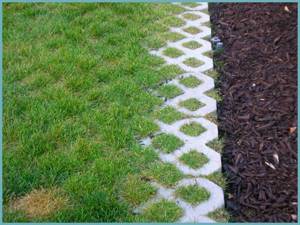
There are slightly fewer disadvantages, but they are also worth considering:
- It is necessary to accurately calculate the load on the grid. The material deteriorates over time. So, plastic varieties are suitable for passenger cars, and concrete varieties are suitable for trucks.
- After rain it is very difficult to remove accumulated water.
- Concrete gratings become very hot from the sun's rays, which negatively affects plant growth.
- The weight of concrete gratings is very large.
Laying method
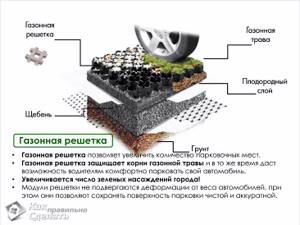
If you have chosen a grille and decided on your goals, you can begin installation. All work is divided into three stages:
- Soil preparation.
- Laying.
- Filling cells.
Soil preparation
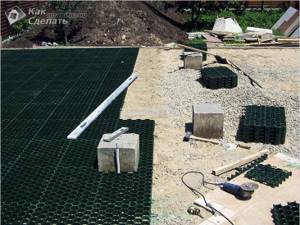
First you need to mark the territory. Then you need to remove the top layer of soil in order to then fill it with the necessary components. The depth depends on what you ultimately want to see. Next, add gravel mixed with sand. If parking for freight vehicles is provided, then this layer should be thick enough, from 30 to 50 cm. For parking passenger vehicles, the thickness of the cushion with sand and gravel is 25-30 cm. For entering a garage, 20-25 cm. For a children's playground, 15-25 cm is enough. 20 cm.
You need to pour sand on top 2-3 cm and level the surface. To prevent gravel from mixing with sand and soil, many people spread geotextiles between the layers and on the base of the pit.
Laying
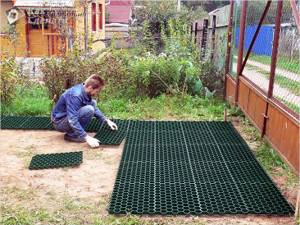
Now you can start installation. The modules are fastened together (they have special fasteners) and laid on the surface. Usually the laying goes in rows from left to right. Plastic modules can be easily cut if necessary. Therefore, you can create lawns of any shape: square, round, triangular, etc. It all depends on your desire and imagination. Installing a lawn grate is a very exciting process that gives room for creativity.

Installation of concrete grating
The color of lawn grate links is most often chosen to be brown or green. As the grass emerges and grows, the plastic edges will no longer be visible. For paths, you can use modules of a different color. It all depends on your creative ideas.
Filling cells
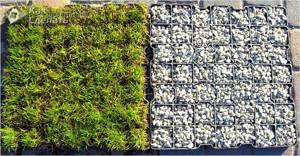
The cells are half filled with fertile soil if you want your lawn to be green. Then you need to sow the grass seeds and fill the grate with soil to the edges. The soil in the cells must be nutritious and fertile.
Some experts believe that 5 cm of fertile soil is not enough to keep the lawn fresh and green for many years. When the roots grow and go deep, they will have nothing to eat. The sand and gravel layer do not contain substances necessary for plants. Water doesn't stay there either. Such a lawn will dry out quickly. If it is a lawn at the dacha, they advise placing geotextiles and a layer of soil on the sand layer. Then lay the grate and fill it with earth.
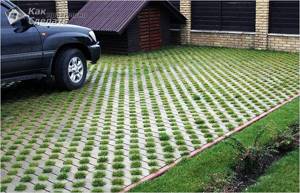
Concrete lawn grate
For paths, the cells can be filled with small pebbles. There will be no dirt on them after the rain. Your dacha or garden will always be clean and comfortable.
Recently, lawn gratings have been used very widely. Perhaps you will find some new areas of application for it, come up with your own effective styling methods and create unique creative compositions.
Types of lawn gratings
Concrete grating is strong and durable. No special preparation is required for installation; it is used even on heavy soils.
Polymer lawn gratings.
There are plastic lawn grates used for similar purposes. You can find out more about them in a separate article: plastic lawn gratings.
Here we will consider only concrete and similar polymer gratings.
Polymer lawn gratings are made from combinations of various materials. The most common of them are: polyethylene and polymer-sand gratings.
Thanks to the use of various components in the lattice structure, some of their properties can be changed. For example, increased resistance to impact loads or the ability to more conveniently fasten elements together.
Despite their composition and name, polymer gratings are close in their properties and principles of installation and operation to concrete gratings, so they can be considered together.
Types of concrete gratings by shape
Based on the shape, we can distinguish two types of eco-tiles: honeycomb and square. Square ones can withstand loads of up to 400 tons per m², so they are used for areas intended for intensive use.

Square eco-tiles can withstand maximum loads.
Gratings with honeycomb-shaped cells are designed for a maximum load of 20 tons per m². They are a good option for playgrounds, sidewalk paths, and parking lots for cars. The most common size of concrete lawn grating is 600 x 400 x 100 mm.
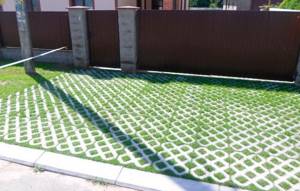
Lattices with honeycombs.
These concrete structures most often have their natural color - gray, but some manufacturers introduce a coloring component into the original composition. Such products are more expensive, but the lattice in blue, yellow, red, brown colors stands out beautifully against the background of a green lawn.
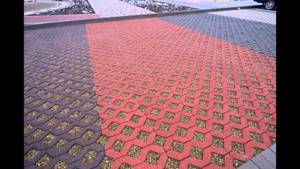
Lawn gratings of different colors.
The products differ from each other and in the height of the wall. Depending on this size, the grate can withstand a particular load.
Types of gratings depending on production method
There are two methods for producing concrete gratings: casting and vibrocompression. In the first case, the products are formed by pouring liquid concrete mixture into molds and then allowing it to harden. The design contains reinforcement elements that increase its strength.
When using the second method, vibratory compaction equipment is used. The starting material is semi-dry concrete mixture. It is placed in a special form, where everything is mixed and distributed evenly over the surface of the matrix. The resulting product has no voids, chips or cracks. This method is less labor-intensive and more productive than the first.
Concrete
A parking grid on a lawn can also be made of concrete. It is produced in the form of stamped blocks made by casting or vibration pressing. The standard size of such products is 60×40×10 cm. If desired, the size can be changed in accordance with an individual order. The cells of the concrete lattice effectively protect plant roots from external influences. In addition, structures of this type can be used to protect against erosion.
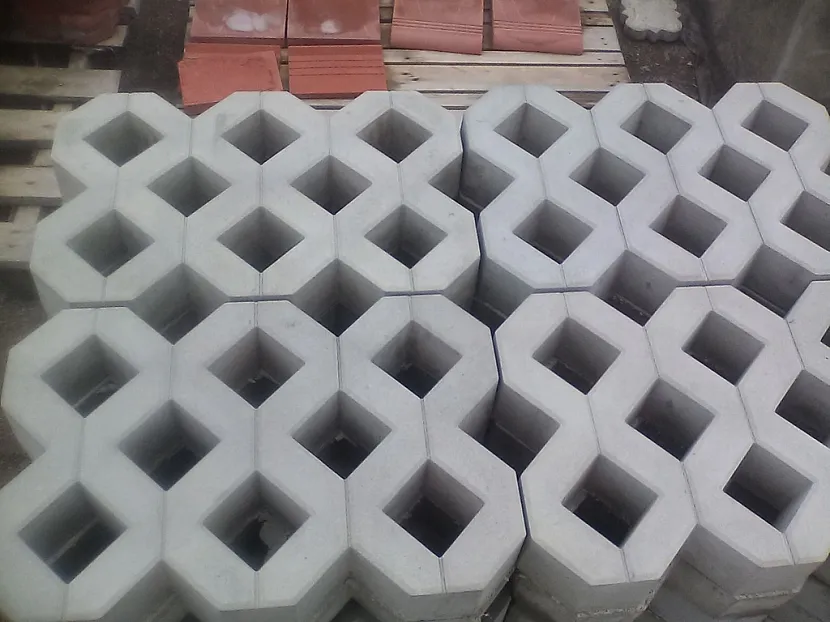
Concrete gratings for lawn decoration Source buildor.ru
Kinds
All manufactured concrete gratings can be classified according to their shape into the following groups:
- Honeycomb-shaped. Able to withstand loads of up to 20 tons. Concrete honeycombs for lawns and parking are used for arranging sidewalks, car parks and playgrounds.
- Square. Can withstand loads of up to 400 tons. Used for arranging places with very high traffic intensity.
Concrete gratings can be produced in almost any color range. It all depends on the coloring pigment used. The most affordable ones are gray ones.
Advantages:
- Durability. The average service life of such products is 10-15 years.
- Possibility of use on almost any soil.
- High strength indicators. Ideal for arranging areas with constant high loads.
- Affordable price. Compared to lawn mesh, the cost of concrete gratings is significantly lower.
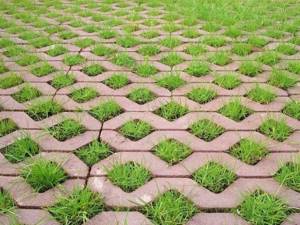
Painted concrete “Snakes” for creating gratings for the lawn Source cckomplekt.ru
Flaws:
- Sparse grass cover. Even after complete overgrowth, concrete islands are clearly visible.
- Large weight of products, which requires special delivery conditions.
- Difficult installation. Laying gratings is possible only when using special equipment.
Advantages and disadvantages
The lawn structure for eco-parking has many advantages that make the lattice stand out against the background of asphalt and tiles. Concrete used in the manufacture of geogrids is a good alternative to plastic modules. Such cells are stronger than their plastic counterparts. At the same time, the gratings can reliably protect the lawn: it will be preserved better than plants that were sown using traditional technology. Cars driving on the concrete support will not crush the grass, since it will be located in a niche.
Concrete geogrids have other advantages:
- grates allow rainwater to penetrate directly into the soil without interfering with plant growth;
- products are presented in different sizes and shapes of cells; in addition, it is possible to manufacture parking products according to sketches to order;
- During production, concrete mortar of different colors is used, so you can choose a shade that suits the landscape design;
- lawn or parking gratings are laid on sites; they can also become an alternative to conventional tiles, which are used for laying sidewalks.
The eco-parking structure is a universal product used in private and public areas, since its service life is at least twenty-five years. In addition, the color saturation of the cells does not disappear under the influence of ultraviolet radiation and precipitation - they remain bright for a long time. Products do not deteriorate due to the influence of low temperatures.
However, such structures also have their disadvantages that must be taken into account during installation. First of all, the material from which they are made does not allow the production of thin walls of the gratings, which often does not coincide with the architecture located nearby
It should also be taken into account that the installation of the slab material involves installation and fixation in the soil, which implies additional financial costs for the work
Building materials are classified according to several main characteristics. We are talking about the shape and color of the gratings. In particular, the form depends on their purpose and happens:
- honeycomb-shaped (products can withstand loads of up to about twenty tons per square meter, so they are used when arranging sidewalks or bicycle paths, parking lots for cars and playgrounds for children);
- square (grids are intended for constructing areas where vehicle traffic is especially intense; they are able to withstand heavy loads - about four hundred tons per square meter).
The range of cell shades is varied. Products made using coloring pigment are sold at a higher price. The most popular shade is gray, since its cost in comparison with other products is minimal. The designs also come in red, brownish, yellow, green and blue.
Plastic gratings
If you have already decided to install lawn gratings for parking with your own hands, then you can choose plastic structures, which are considered the most modern. This installation is based on high-strength material that can withstand loads of up to 1.2 tons per 1 square meter. The service life of such a grill is also long and can reach 25 years. The shape of plastic gratings can be different.
If you decide to use plastic lawn gratings for parking on your territory, you can install them yourself using special locks that ensure reliable fastening of the modules into one frame. In this case, you do not need to use special equipment. If there are geometrically irregular areas on the territory, then a plastic lawn grate can be laid according to the territorial features of your site. Such structures are very resistant to the chemical effects of petroleum products and acids. Such elements do not melt under the influence of ultraviolet radiation; in addition, they are not afraid of frost and retain their characteristics and qualities under harsh external conditions.
Material for making lawn gratings
Important! The structures being installed must be able to withstand heavy loads for a long time, be immune to extreme heat and cold, and not absorb moisture. Very durable materials are used for their manufacture - plastic (polyethylene, polypropylene) and pressed concrete
Plastic modules
The material can withstand heavy weight (up to 80 tons per sq. m.) and is highly resistant to sunlight, seasonal precipitation, and strong temperature changes. Can last up to 20-25 years.
In a lawn grate, plastic blocks are securely attached to each other with pins, resulting in a solid structure that distributes the load. Due to their low weight, plastic modules can be delivered and installed by hand. It takes 20-30 minutes to work with 1 sq. m, if all the preparatory work has been done before.
Note! It is easy to calculate the required number of blocks for the area they cover, and also to cut some of them with tools to the required shape. Thin bridges allow you to fill up to 90% of the trellis area with plants
Therefore, the lawn mesh is almost invisible in the overgrown grass. For the same purpose, the blocks can be given green color, or any other color you wish.
Thin bridges allow you to fill up to 90% of the trellis area with plants. Therefore, the lawn mesh is almost invisible in the overgrown grass. For the same purpose, the blocks can be given green color, or any other color you wish.
The disadvantages of plastic gratings include: higher cost compared to concrete ones; the sharpness of the edges of the cells, on which you can accidentally cut off overgrown blades of grass.
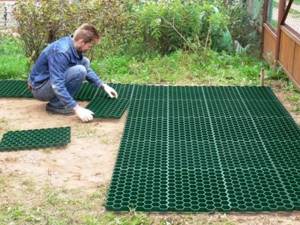
Plastic modules
Concrete modules
Durable and hard material, tolerant of loads of up to 20 tons per sq. m. It performs well on hard soil and easily replaces other types of surfaces for country paths. The service life is 12-15 years.
Note! Concrete is less durable due to its contraction and expansion as ambient temperatures change. You should check for the presence of special cells that prevent the main part of the product from cracking
Thick concrete walls occupy 50% or more of the area of the entire lawn lattice, the rest falls on the share of plants. The grass does not cover the structure, which generally resembles paving slabs with holes in appearance.
Concrete modules have a high mass and require the use of trucks for transportation and specialists for installation. But the cost of such blocks is less than plastic ones, and preparation for their installation is much simpler.
How to lay a lawn lattice
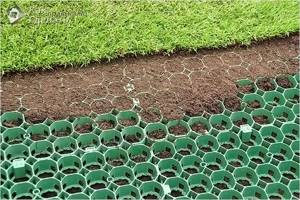
Is it possible to harmoniously combine technical progress, convenience, cleanliness, beauty, soil strengthening, and plant protection? This task will be accomplished by using special structures that were first developed in 1994 in Germany. We are talking about lawn gratings. In this article you will find information about the types of lawn grates and the possibility of using them in different areas, and you will also learn how to lay a lawn grate yourself.
A lawn lattice is a durable covering that is made from separate small sections, called modules, interconnected by locks. Each individual module has a structure in the form of cells, shaped like honeycombs, rhombuses, squares with a minimum height of 4–5 cm.
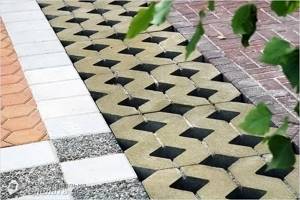
The grid modules are made of concrete or very durable plastic. Any variety has its pros and cons. The choice depends on what problems need to be solved.
Made from concrete
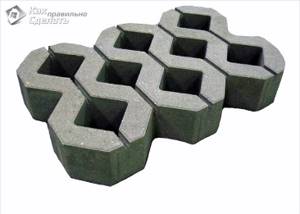
The first gratings were made from concrete. Now they are used much less frequently, but have a number of advantages:
- They are very durable and can withstand heavy loads (these properties will be very useful in parking lots intended for trucks).
- The cost of concrete products is low, much less than that of plastic.
- There is no need to carry out complex work in preparation for installation.
- The service life is quite long.
- In the area where the concrete grate is laid, water from rain does not linger and leaves quickly (there will be no dirt or excessive waterlogging of the lawn).
But unfortunately, a lattice made of concrete blocks has very significant disadvantages, which forced us to look for the possibility of using other materials:
- The modules are heavy and installation requires special equipment.
- The concrete walls are thick, so it is visually possible to create the appearance of an even green massif; the walls of the concrete modules are always clearly visible.
Made of plastic
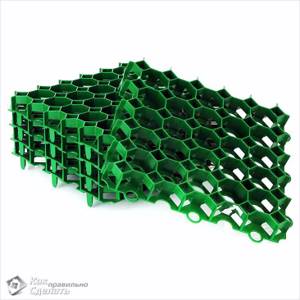
Plastic gratings have earned the greatest popularity, since they have many more advantages than their concrete counterparts:
- The modules are light in weight, securely and quickly fastened together.
- No special equipment is needed for installation; absolutely anyone can install it with their own hands.
- Fast installation speed.
- The cells have thin walls, they will not be visible when the grass grows, the result is a continuous green massif.
- Quite high strength.
- Good drainage properties, retains the moisture in the cells necessary for good grass growth, but excess water leaves.
- A variety of cell shapes (honeycombs, squares, crow's feet and others).
- Different colors of links (modules).
- Strengthens the soil.
- In parking lots, in the courtyards of residential buildings, in country houses, an aesthetic appearance is created, there is no dirt after the rain.
- Does not harm the environment (does not release substances into the atmosphere and soil that have a negative impact on human health).
- The grass bends under car wheels or feet, but is not damaged.
- Convenient to care for your lawn.
- Withstands severe frosts.
- Can last 20 years or more.
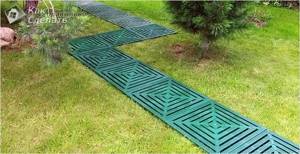
Disadvantages of plastic lattice:
- It is inferior in strength to concrete and is not suitable for truck parking.
- The need to prepare the soil, fill it with sand and gravel so that the plastic links do not sag.
Where is lawn grating used?
There are quite a lot of directions for its application, it all depends on the imagination of the owner of the land plot.
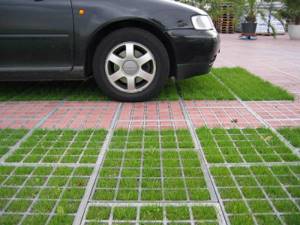
For example, most often they install a lawn grate with their own hands in the following cases:
- arrangement of the local area;
- construction of a playground;
- formation of pedestrian paths in the garden and park area;
- creation of a golf course.

Important! Separately, we note that a lawn grid is also used for parking, allowing you to maintain the integrity of the formed coating for a long time. Watch the video, which clearly shows an example of arranging a parking lot in the form of a green zone.
Laying technology
The sequence of installing a concrete structure is quite trivial; even an inexperienced summer resident can lay the module with his own hands.
Marking
First, you should mark the area where you plan to lay the grating. It is not recommended to install concrete modules on slopes exceeding 5%. The type of construction depends on the purposes for which the lawn will be used: arrangement of a camping site, parking for cars, etc.
Work with soil
- the height of the gravel cushion, which is 5-25 cm (the specific value is determined by the planned loads on the lawn, for example, for a parking space it is recommended to set this parameter to the maximum value);
- height of the leveling layer - approximately 2-3 cm;
- the height of the concrete structure is about 5 cm.
As a result of calculations, it turns out that about 27-28 cm of soil should be removed to install the grate.
Pouring concrete and installing grating
At the end of the excavation work, the soil is compacted and the boundaries of the pit are strengthened by laying stones or pouring a concrete mixture. Then a sand and gravel cushion is laid. First, a layer of gravel is poured, and geotextiles are laid on top of it. This material protects the area from the growth of weeds. The next layer is sand (2-3cm). It ensures a tight fit of the gravel and increases the mechanical stability of the structure.
The concrete grating is installed with the wide surface down. All rows are shifted one cell towards each other (chessboard order). In order for the modules to easily take their position, they must be fastened together at an angle of 45º. In places where the entire module does not fit, pieces of the required size should be cut using a carbide circular saw.
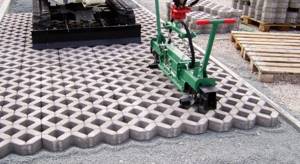
The cells of the concrete structure should be filled with fertile soil mixture. You can use peat, compost, and a mixture of soil and gravel in equal proportions. After abundant watering, the soil will settle a little, then it can be planted with grass and rolled out along the entire perimeter of the lawn.
The service life of the grate depends on the mode of its use, as well as the brand and quality of the concrete mixture. Such structures retain their performance characteristics for a long time - 30-50 years.
Concrete gratings are indispensable for protecting lawn grass. They prevent excessive water saturation of vegetation, as they effectively remove rain moisture from the site.
A neatly trimmed lawn with bright green grass - what could be better to decorate a summer cottage or area near a house or shop?
But a lawn planted with your own hands in dug up soil does not look so neat, and as a result of walking on it, as well as under the influence of weather factors, very soon it will completely lose its appearance, the grass will turn yellow and thin out. A lawn grid is used for this.
Fortunately, there are modern means with which you can create a perfectly smooth lawn that will not change its appearance even over a long time.
The lawn grate is a special design in the form of modules made of concrete or plastic, connected to each other with latches. The main purpose of the trellis is to protect plant roots and strengthen the soil.
Most often, a lattice is purchased for a summer residence. It can be used for parking, playgrounds and other places in the garden.
Installation
If you are interested in installing not just a mesh for a lawn, but specifically a mesh for eco-parking, then this material will help you choose the right design:
- The material must be made of 100% polyethylene without impurities, otherwise you should expect deterioration in the properties of the lawn mesh;
- The thickness of the mesh walls must be no less than 0.5 cm;
- In order for the grid system to be as strong and stable as possible, care must be taken to securely fasten the modules. A good way is a groove lock, which will connect the modules into a solid structure. Although, in addition to unsuccessful fastening, the quality of fixation can also be negatively affected by a poor base for the grille.
Installing lawn gratings and netting next to parking spaces is a very important step in creating a holistic picture in the exterior. Lawn nets are truly indispensable assistants in this matter.
Installation of ecological parking (video)
To install a mesh under the lawn:
- Prepare reliable drainage;
- How you compact the underlayment under the lawn and its thickness determines the purpose of its use (parking lot, path, etc.);
- On top of the soil base, lay crushed stone in a layer of 30-40 cm, then a substrate of geotextile fabric, then sand and gravel in a 5 cm layer;
- If you want to make a slope for decorative purposes, then you can play with the height of the gravel layer and make a stop at the base, which can be removed after the grass has sprouted;
- We recommend installing the gratings in a checkerboard pattern for structural stability;
- Place special markers inside individual cells to indicate parking spaces, for example;
- Fill the honeycombs of the modules with a mixture of sand, peat or compost, water and water throughout the entire period of seed germination;
- Some experts advise leaving the cells empty by approximately half 1 cm, and some insist on filling the cells with soil to the end;
- Limit traffic on your newly seeded lawn.
Laying lawn grating on the site
A neatly trimmed lawn with bright green grass - what could be better to decorate a summer cottage or area near a house or shop?
But a lawn planted with your own hands in dug up soil does not look so neat, and as a result of walking on it, as well as under the influence of weather factors, very soon it will completely lose its appearance, the grass will turn yellow and thin out. A lawn grid is used for this.
Fortunately, there are modern means with which you can create a perfectly smooth lawn that will not change its appearance even over a long time.
The lawn grate is a special design in the form of modules made of concrete or plastic, connected to each other with latches. The main purpose of the trellis is to protect plant roots and strengthen the soil.
Most often, a lattice is purchased for a summer residence. It can be used for parking, playgrounds and other places in the garden.
Advantages of a lawn lattice
- The light weight of the grill makes it easy to transport on any car.
- The convenient design facilitates quick assembly right on site.
- High frost resistance (up to -40 C).
- Easy to maintain. After laying the grate, the lawn is not deformed, cutting is quick and easy. The use of any tools is allowed (trimmers, gasoline and electric lawn mowers, gas mowers).
- Environmental friendliness. Lawn mesh is produced from environmentally friendly material.
Types of lawn gratings
Currently, two types of gratings are offered on the building materials market: plastic and concrete. Therefore, the buyer always faces a difficult question of choice.
Plastic mesh for lawn
Green areas made of plastic lattice have a more neat appearance due to the thin walls of the plastic cells. Laying a plastic lawn grate is easier and does not require the use of special equipment.
With all other indicators of strength and reliability being equal, a plastic lattice allows you to create the most natural lawn.
Concrete lawn grate
Concrete lawn gratings are the ancestors of these devices. The main advantages of a concrete structure are its high strength and reliability.
In addition, concrete lawn gratings are more suitable for use in areas with dense soils, where it is not possible to create optimal groundwater drainage and good water drainage in the event of heavy rainfall.
But at the same time, such a lawn does not look very attractive in a parking lot, because... is a green area with concrete islands.
Do-it-yourself lawn grating installation
How to lay a lawn grate without the help of third parties? In fact, this is a rather painstaking and complex process.
But if you follow the following algorithm of actions, you can create an aesthetically attractive and reliable lawn yourself:
- We prepare the area. We select the soil until a depression with a depth of 9 to 11 cm is formed.
- We level the surfaces and compact the soil.
- We fasten the edges of the grille. To do this, we place ordinary stones in the concrete solution or use anchors attached to the ground.
- We create the underlying layer. Pour a layer of mixture 3-5 cm high, which consists of 80% gravel and 20% soil.
- We lay a layer of road mesh or geotextile on the gravel.
- As an additional layer we line a small mesh.
- Now we lay the lawn lattice with the wide surface down and the lattice side up. We shift the rows by one cell towards each other. We fasten the modules together at an angle of 45 degrees so that they can easily take the position we need.
- If necessary, we adjust the size of the grating to the desired parameter using a carbide circular saw used to shorten the modules.
- Fill the grate with a mixture of medium-sized soil and gravel (in equal proportions).
- We sow lawn grass and don’t forget to water it regularly.
- Keep in mind that you should sow the seeds 2-3 cm below the very top of the trellis. This will prevent damage to the grass.
If you followed all the steps correctly, very soon you will be enjoying the lush and vibrant grass that you planted yourself.
Grating for paths in the country: specifics of material use
By purchasing plastic gratings for paths in the country at a construction supermarket, in addition to saving money on the material, hacienda owners will experience other benefits.
This material is quite specific. In its appearance and structure, it is very different from the usual raw materials for the construction of garden paths - natural stone, gravel, concrete mixture, etc. But at the same time, the gratings have an impressive list of advantages: - a guarantee of maintaining the aesthetic appearance of the site after the construction of the path;
— the convenient and simple principle of connecting the gratings is reliable, so during the operation of the trail the owner will not be upset because the modules have come apart, become deformed or disconnected, because the risk of damage to them is minimal;
- possibility of use in areas of the site with high load - in parking lots, courtyards and patios;
— the cellular structure helps to evenly distribute weight, having a beneficial effect on the safety of paths in the garden and the period of their active use;
— the chemical inertness of the material indicates that the site will not be contaminated with any toxins or harmful emissions;
— a path built from gratings helps to keep the yard clean, because soil and sand will not spread outside the garden.

Laying technology
In order for the prepared lattice for garden paths to meet all the hopes of the site owners, it must be correctly laid in accordance with the requirements of the technology. To begin with, they prepare the territory along which the trail route runs - it is cleared of plants, litter and top fertile soil layer, and then leveled and compacted.
After completing the preparatory work, they begin laying the gratings. Each lattice is connected to an adjacent module using the locking principle, and then the hollow cells inside them are filled with fertile turf soil or a special substrate. Lawn grass is sown in it, after the germination of which, the path will acquire a harmonious and most natural appearance, but at the same time ensure safety and stability when moving along the path.
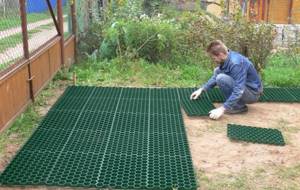
If the laying work is carried out correctly, the finished trail will meet the following requirements:
- The presence of a flat, hard surface for comfortable movement without trampling the grass layer.
- Ensuring optimal moisture and air exchange is necessary for lawn grass to grow in an ideal microclimate.
- Preventing the destruction of the earthen layer due to the presence of hard sides in the grids on the path.

Selecting tools for work
In order for a lawn lattice for paths in a dacha to please the owners with its functionality and practicality, its construction must be approached responsibly. The owners of the site will need to not only master the technology discussed above, but also prepare the necessary set of tools. It is basic and includes the following items:
— rope and pegs for marking the territory;
— a rake for leveling the soil and a shovel for removing the top fertile layer of soil;
- yardstick;
— a building level for monitoring the correctness of paving of gratings and timely correction of defects in the form of an uneven surface.
You will also need to buy in advance or prepare with your own hands a substrate for filling the honeycombs, into which high-quality lawn grass seeds will be embedded.
Maintenance of the finished trail
When the work is completed, the owners can only maintain the neat appearance of the path built from lattice. This does not require much time, since maintenance is minimal - with the help of gardening tools, site owners will periodically trim the lawn grass, remove weeds and ensure that the soil moisture level is optimal.
Lawn parking. Lawn grating: features and scope of application
Over time, everything falls into disrepair. And the lawn area, which you lovingly planted, fertilized and watered, will sooner or later thin out and lose its former beauty. To prevent this from happening (and if it did happen, it would be much later than you thought), a rather useful invention was invented - a lawn grate. As we have already written, cell modules protect the soil - they help the soil not move in different directions under the weight of cars and people. In short, it takes over any mechanical influence. For example, if there is a grate on the lawn and the weight of cars or people presses on it, then the grass on such a lawn is not afraid of anything; over time, the crushed grass will straighten out.
Using a lawn grate
Each module is fastened together using a latch. Thanks to this, the coating turns out to be a single whole and evenly bears the load. The grass roots remain unharmed, and excess water goes into the drainage under the grate. The grating provides a level surface, which is much cheaper than laying asphalt or pouring concrete.
The height of the grille edge can be different, depending on its purpose. Patterns also vary: diamonds, squares, smooth lines. Available in different colors.
We have already mentioned that lawn nets have a wide range of applications. Here are some more ideas of where they can be used:
- Paths for cyclists and pedestrians;
- Embankments;
- Terraces and roofs;
- Camping;
- Parks.
The term "eco" has become mainstream in the field of construction and landscape design. If we talk about the so-called Green building means keeping energy and water consumption as low as possible. If we talk about landscape design in line with our article, then we need to mention eco-parking.
We know very well that in order to prevent channels and depressions from forming in car parks, the space under the car needs to be strengthened. A lattice will cope with this task, taking up only half of the coverage, and the rest of the space will be given to greenery. So much for eco-parking.
How to style
The technology for laying lawn gratings is so simple that even a person who is not skilled at such work can design a parking lot or garden path. But the very first step should be to calculate the required number of modules. To do this, use a simple mathematical operation (S pads: S fragment).
Having chosen the desired lattice option (taking into account the expected loads), they begin to act according to the following algorithm:
- Having marked the perimeter of the site, they begin to dig a pit (from 10 to 30 cm deep);
- if a constant load is planned, a gravel-sand “cushion” 5-20 cm thick is laid on the bottom;
- when laying plastic gratings, you will need a small layer of geotextile to protect against weeds, sinkholes, and flooding;
- the next layer is a leveling layer, consisting of sand (2-3 cm);
- Now you can lay the tiles by adjusting the size and shape.
When the entire site is decorated, the cells are filled with soil most suitable for forming a lawn. After watering abundantly, wait until the ground settles and sow the area with grass, placing the seeds 2 cm below the edge of the lattice. If necessary, apply mineral fertilizers.
Lawn grass that kills weeds
Important! The planted lawn is watered again and left undisturbed until the grass sprouts. This pause is necessary so as not to harm the roots.
Characteristics
The performance characteristics of the grating tiles are determined by the properties of the material:
- concrete is not subject to rotting or corrosion;
- subject to production technology, the monolith tolerates low and high temperatures, as well as their sharp fluctuations;
- the material does not contain components harmful to the environment or humans, is environmentally friendly and durable;
- The variety of colors and color fastness allows you to choose slabs for any design solution.
Geogrid is used for:
- paving paths and areas for any purpose;
- creating a decorative border;
- strengthening the shore of an artificial reservoir;
- design of a site with a complex profile.

